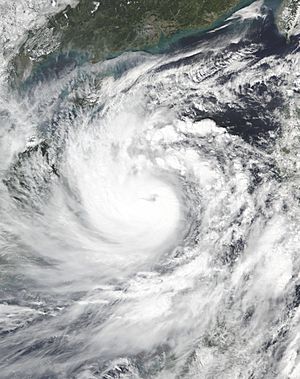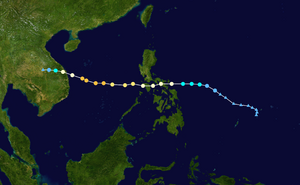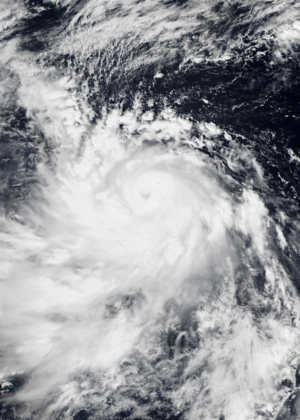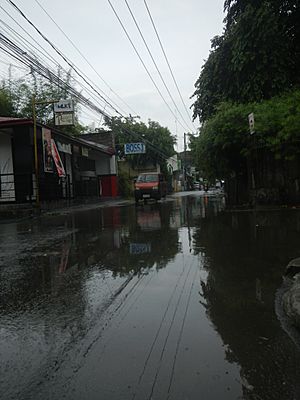Typhoon Molave facts for kids

Typhoon Molave at peak intensity on October 27
|
|
| Meteorological history | |
|---|---|
| Formed | October 22, 2020 |
| Dissipated | October 30, 2020 |
| Unknown strength tropical cyclone | |
| 10-minute sustained (JMA) | |
| Highest winds | 165 km/h (105 mph) |
| Lowest pressure | 940 hPa (mbar); 27.76 inHg |
| Category 3 tropical cyclone | |
| 1-minute sustained (SSHWS/JTWC) | |
| Highest winds | 195 km/h (120 mph) |
| Lowest pressure | 952 hPa (mbar); 28.11 inHg |
| Overall effects | |
| Fatalities | 71 deaths |
| Missing | 46 |
| Damage | $742 million (2020 USD) |
| Areas affected | Philippines, Spratly Islands, Vietnam, Laos, Cambodia, Thailand, Malaysia, Myanmar |
|
Part of the 2020 Pacific typhoon season |
|
Typhoon Molave, also called Typhoon Quinta in the Philippines, was a very strong tropical cyclone. It caused a lot of damage in the Philippines and countries in Indochina during October 2020. It was the strongest storm to hit the South Central Coast of Vietnam since Typhoon Damrey in 2017.
Molave was the 18th named storm and the 8th typhoon of the 2020 typhoon season. It started as a tropical depression (a weak storm) on October 23, east of Palau. The next day, it grew into Tropical Storm Molave. It then became a typhoon on October 25.
The typhoon made five landfalls (hit land) in the central Philippines. After this, Molave moved into the South China Sea and became stronger again. It reached its strongest point on October 27. As it got closer to Vietnam, it started to weaken. Molave hit Vietnam on October 28 and quickly became weaker as it moved further inland. The storm finally disappeared over Myanmar on October 30.
Typhoon Molave caused 71 deaths, and 46 people were reported missing. The damage from the storm is estimated to be around $742 million (USD).
Contents
How Typhoon Molave Formed and Moved

On October 23, 2020, the Japan Meteorological Agency (JMA) started watching a tropical depression. It was about 190 nautical miles (350 km) north of Palau. On the same day, the Philippine weather agency, PAGASA, also began tracking it. They named it Quinta.
The next day, the Joint Typhoon Warning Center (JTWC) also recognized it as a tropical depression. Later that day, it became a tropical storm. The JMA officially named it Molave.
On October 25, PAGASA upgraded Molave to a severe tropical storm. It was getting closer to the Bicol Region in the Philippines. Soon after, PAGASA made it a typhoon. This caused a high storm warning (TCWS#3) for Albay and Camarines Sur provinces. The JMA and JTWC also upgraded it to a typhoon.
Molave made its first landfall on San Miguel Island in Albay at 6:10 PM Philippine time. It hit Malinao just 40 minutes later. The typhoon made three more landfalls:
- In San Andres, Quezon at 10:30 PM.
- In Torrijos, Marinduque at 1:20 AM on October 26.
- In Pola, Oriental Mindoro at 3:30 AM.
Molave then moved over the South China Sea. It continued to get stronger as it left the Philippines. The state of Sabah in Malaysia was also affected. Rough seas with waves up to 3.5 meters (11.5 feet) were reported. Molave became a powerful Category 3 typhoon.
As the storm moved west, it slowly weakened while approaching Vietnam. It made landfall in Quảng Ngãi province, central Vietnam, at 10:10 AM UTC+7 on October 28. At this point, it was a Category 2 typhoon.
Once it hit land, the storm quickly weakened. The JTWC stopped tracking it as a typhoon on October 29. The JMA continued to track it as a tropical depression over Cambodia. Molave finally disappeared over Myanmar on October 30.
Getting Ready for the Storm
Philippines Prepares
On October 24, 2020, the Philippine Institute of Volcanology and Seismology (PHIVOLCS) warned about lahars (mudflows) from Mayon Volcano. These could happen in the Bicol Region during the typhoon.
Almost 9,000 people had to leave their homes in the Philippines. Sea travel was stopped as the storm got closer. The start of the 2020 Philippines Football League (PFL) season was delayed. This was due to the bad weather and some players getting sick. Classes and government work were also suspended in some areas on October 26.
Vietnam Prepares
About 1.3 million people were expected to evacuate in Vietnam. Prime Minister Nguyen Xuan Phuc ordered boats to come ashore. He also told security forces and residents to get ready. The prime minister compared Molave to Typhoon Damrey from 2017.
Hundreds of flights were canceled, and schools had to close. The government sent about 250,000 troops and 2,300 vehicles for rescue missions. Members of the Vietnamese military helped people get onto evacuation buses. They also helped guide boats to safety. Some even helped residents put sandbags on their roofs. On October 27, the city of Da Nang asked people to stay home starting at 8:00 PM UTC+7. They also urged workers not to come to work the next day.
What Happened After the Storm
| Countries | Fatalities | Damage (2020 USD) |
Ref | |
|---|---|---|---|---|
| Death | Injured | |||
| Philippines | 27 | 40 | $87.1 million | |
| Vietnam | 41 | 143 | $573 million | |
| Malaysia | 2 | 0 | Unknown | |
| Thailand | 1 | 3 | $17 million | |
| Cambodia | 44 | Unknown | $65.4 million | |
| Totals | 116 | 186 | $742 million | |
Impact in the Philippines
Typhoon Molave hit the Philippines on October 25 with winds of 130 km/h (81 mph). The National Disaster Risk Reduction and Management Council (NDRRMC) reported damaged roads and bridges. There was also flooding and landslides. Many villages and farms were flooded. Power lines and trees fell, causing power outages in Albay, Sorsogon, Batangas, and Cavite.
About 120,000 people had to leave their homes. Over 1,800 workers were stuck in ports. A state of calamity was declared for Batangas on October 27. This was because of the "widespread destruction and substantial damage" from the storm.
A yacht off the coast of Batangas Province sank. Seven fishermen were rescued, but 12 others were missing near Catanduanes. Floods in Quezon from Typhoon Saudel got worse because of Molave. Molave also affected areas that were still recovering from Typhoon Kammuri (Tisoy) a year earlier.
Damage to farms in the Bicol Region reached ₱286 million (US$5.9 million). Molave damaged 6,671 houses, and 243 of them were completely destroyed. In Oriental Mindoro, farm losses were estimated at ₱2 billion (US$41.3 million). The Philippine government sent ₱890.5 million worth of food and other items to help those affected.
As of November 9, the NDRRMC reported that 27 people died. Also, 40 people were injured, and four went missing. Damage to buildings and farms was ₱1.56 billion (US$32.2 million) and ₱2.66 billion (US$54.9 million), respectively. The total damage across the country was ₱4.22 billion (US$87.1 million).
Impact in Vietnam
On October 27, the typhoon caused two Vietnamese fishing boats to sink in the South China Sea. Rescue teams searched for 26 missing fishermen.
Molave began to affect Vietnam on the evening of October 27. By the morning of October 28, the entire island of Lý Sơn lost electricity. The island, with 20,000 people, was hit by 165 km/h (103 mph) winds for hours. Waves as high as 6 meters (20 feet) crashed onto Vietnam's coast.
Molave caused widespread damage in Central Vietnam. Wind gusts reached 176 km/h (109 mph) in Quảng Ngãi city. Molave also brought heavy rains. Sơn Kỳ (Quảng Ngãi) received 470 mm (18.5 inches) of rain in 24 hours. The heavy rain caused three landslides in Phước Sơn and Nam Trà My districts. Some villages were buried, and at least 21 bodies were found. Flooding also trapped 200 workers at the Đăk Mi 2 hydroelectricity plant.
The typhoon, floods, and landslides destroyed or damaged 188,759 houses and buildings. It also flooded 31,928 other places and 27,970 hectares (69,115 acres) of crops.
Molave killed 41 people in Vietnam, injured 143, and 42 others went missing. The economic losses were 13.27 trillion dong (US$572.9 million). This included 6.08 trillion dong (US$262.6 million) in Quảng Nam and 5 trillion dong (US$215.7 million) in Quảng Ngãi Province.
Impact in Malaysia
On October 27, the typhoon caused a ship called MV Dayang Topaz to crash into a drilling platform. This happened 14 nautical miles (26 km) off Miri after one of its anchor cables broke. The Malaysian Maritime Enforcement Agency helped with a rescue operation. Two of the 187 people on board were killed.
Impact in Thailand
On November 1, one person was reported dead from floods in northeastern Thailand.
Typhoon Names Retired
On November 13, PAGASA announced that the name Quinta would no longer be used for typhoons. This is because it caused almost ₱5 billion in damages. In January 2021, PAGASA chose Querubin as its replacement for the 2024 season.
In the spring of 2022, the Typhoon Committee said that the name Molave would also be removed from the list of typhoon names. The committee decided that Narra would replace Molave.
See also
 In Spanish: Tifón Molave para niños
In Spanish: Tifón Molave para niños
- Weather of 2020
- Tropical cyclones in 2020
- Other tropical cyclones named Molave
- Other tropical cyclones named Quinta
- Typhoon Durian (2006) – A strong typhoon that affected similar areas.
- Typhoon Ketsana (2009) – A very deadly typhoon that hit similar areas.
- Typhoon Rammasun (2014)
- Typhoon Kammuri (2019) – A powerful typhoon that affected the same areas a year before.
- Typhoon Goni (2020) – A powerful typhoon that affected the same areas just one week after Molave.
Images for kids





